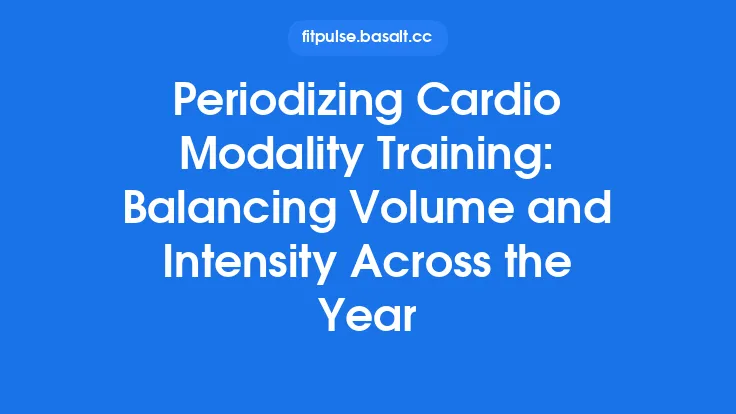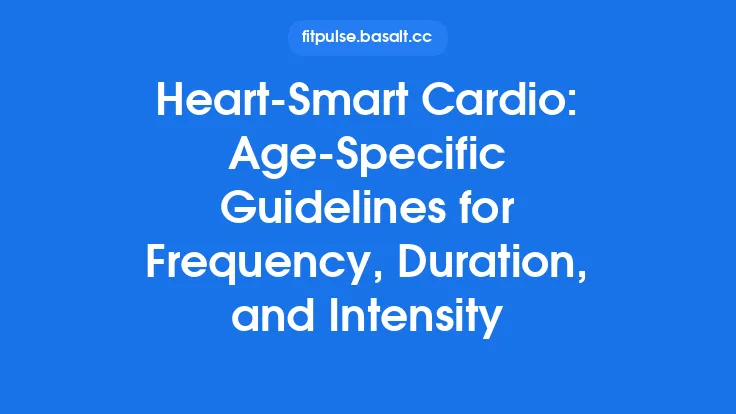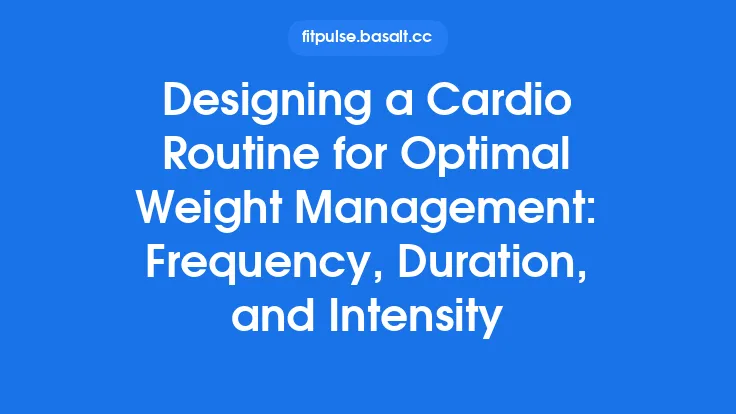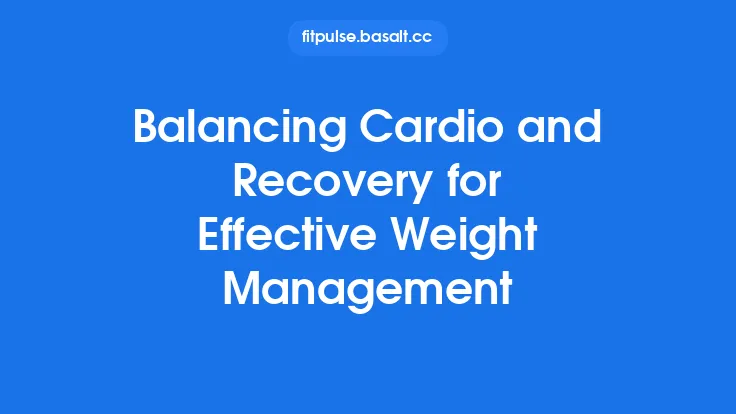Adult cardio training sits at the intersection of science and lifestyle. For most adults, the goal isn’t simply to burn calories or finish a race; it’s to cultivate a cardiovascular system that can sustain high‑quality performance today while preserving heart health and functional capacity for decades to come. The following blueprint breaks down the physiological foundations, training variables, and lifestyle considerations that enable adults to balance intensity with longevity, delivering peak performance without sacrificing long‑term well‑being.
Understanding Adult Cardiovascular Physiology
The adult heart and vascular network differ markedly from those of younger athletes and older adults. By age 30‑40, maximal oxygen uptake (VO₂max) typically peaks and then begins a gradual decline of roughly 1 % per year. This trajectory is driven by several interrelated factors:
| Factor | How It Affects Performance | Practical Implication |
|---|---|---|
| Cardiac Output | Stroke volume plateaus, while heart rate reserve narrows. | Training that emphasizes stroke‑volume expansion (e.g., longer aerobic intervals) can offset the natural reduction in maximal heart rate. |
| Capillary Density | Reduced capillarization limits oxygen diffusion to working muscles. | Repeated bouts of moderate‑to‑high intensity stimulate angiogenesis, preserving microvascular health. |
| Mitochondrial Efficiency | Mitochondrial biogenesis slows, decreasing aerobic energy production. | High‑intensity interval work (HIIT) is a potent stimulus for mitochondrial turnover, even in seasoned adults. |
| Autonomic Balance | Sympathetic dominance can increase resting heart rate and blood pressure. | Incorporating sessions that promote parasympathetic activation (e.g., low‑intensity steady state) helps maintain autonomic equilibrium. |
Understanding these mechanisms clarifies why a one‑size‑fits‑all approach—simply “run more” or “bike harder”—fails to optimize adult cardio health. Instead, training must be deliberately structured to target each physiological component.
Core Principles of Intensity Management
Intensity is the lever that determines which adaptations dominate a training cycle. For adults seeking both performance and longevity, three guiding principles should shape intensity decisions:
- The “80/20” Distribution
Research consistently shows that elite endurance athletes spend roughly 80 % of training time at low to moderate intensity (below the lactate threshold) and 20 % at high intensity (above threshold). Replicating this ratio yields robust aerobic base development while limiting chronic stress on the cardiovascular system.
- Threshold‑Based Zones Over Arbitrary Percentages
Rather than relying on generic heart‑rate percentages (e.g., “70 % of max”), use functional thresholds such as the ventilatory threshold (VT) or lactate threshold (LT). These markers shift with training and provide a more accurate gauge of effort relative to an individual’s current capacity.
- Progressive Overload with Deliberate Recovery
Incremental increases in intensity (e.g., adding 5 % more work at VT) should be paired with planned low‑intensity weeks (“recovery blocks”) to consolidate gains and prevent maladaptive cardiac remodeling.
By anchoring intensity decisions to these principles, adults can push performance boundaries without accelerating age‑related cardiovascular decline.
Structuring Workouts for Longevity
Longevity‑focused cardio programming balances three core workout categories:
| Workout Type | Primary Adaptation | Typical Session Length | Frequency |
|---|---|---|---|
| Aerobic Base (steady‑state, Zone 2) | ↑ Stroke volume, ↑ capillary density, ↑ mitochondrial content | 45‑90 min | 2‑3 × week |
| Threshold Work (tempo, steady‑state just below LT) | ↑ Lactate clearance, ↑ muscular endurance | 20‑40 min (including warm‑up) | 1‑2 × week |
| High‑Intensity Intervals (HIIT, VO₂max intervals) | ↑ VO₂max, ↑ cardiac contractility, ↑ mitochondrial turnover | 15‑30 min (including recovery) | 1 × week (optional 2) |
A typical week for a 35‑year‑old recreational runner might look like:
- Monday: 60 min Zone 2 run (aerobic base)
- Tuesday: 20 min tempo run at 85‑90 % of LT (threshold)
- Wednesday: Rest or active recovery (light mobility, walking)
- Thursday: 30 min HIIT – 6 × 3 min intervals at 95‑100 % of VO₂max with 2 min jog recovery
- Friday: 45 min Zone 2 bike ride (cross‑training)
- Saturday: Long Zone 2 run, 90 min (gradually extending distance over months)
- Sunday: Rest or low‑intensity activity (e.g., leisurely hike)
The exact distribution can be tweaked based on personal schedule, sport‑specific demands, and recovery capacity, but the underlying structure—dominant low‑intensity work punctuated by targeted higher‑intensity sessions—remains constant.
Selecting Cardio Modalities for Peak Performance
Adults have a wide array of cardio tools at their disposal. Choosing the right modality depends on biomechanical preferences, joint health, and specific performance goals.
| Modality | Strengths | Ideal Use Cases |
|---|---|---|
| Running | High mechanical efficiency, easy to quantify distance/time | Competitive road racing, weight‑bearing bone health |
| Cycling (road, indoor, mountain) | Low impact, excellent for high‑volume training, easy power measurement | Endurance events, cross‑training, joint‑friendly cardio |
| Rowing | Full‑body engagement, strong cardiovascular stimulus, low joint stress | Balanced conditioning, upper‑body involvement |
| Swimming | Minimal impact, breath control, excellent for recovery weeks | Rehabilitation periods, hot climates, improving lung capacity |
| Elliptical / Stair Climber | Adjustable resistance, mimics running without impact | Indoor training when weather or joint concerns limit outdoor work |
Mixing modalities (known as “cross‑training”) not only reduces monotony but also distributes mechanical load across different muscle groups, supporting long‑term musculoskeletal health—a key component of cardio longevity.
Periodization Strategies Tailored to Adult Lifestyles
Periodization—systematically varying training variables over time—helps adults navigate the competing demands of work, family, and fitness. Two periodization models work particularly well for the adult demographic:
1. Linear Periodization with Micro‑Cycles
- Macro‑cycle (12‑16 weeks): Overall goal (e.g., improve 10 km time).
- Meso‑cycles (3‑4 weeks): Gradual increase in volume/intensity, followed by a “deload” week.
- Micro‑cycles (weekly): Specific session layout as described in the “Structuring Workouts” section.
Example: Weeks 1‑3 increase weekly mileage by 10 %; week 4 reduces mileage by 20 % for recovery. Repeat, adding a small intensity boost each meso‑cycle.
2. Undulating (Non‑Linear) Periodization
- Weekly Variation: Each week contains a mix of low, moderate, and high intensity, but the exact distribution shifts day‑to‑day.
- Flexibility: Allows adults to swap sessions around based on work travel, family obligations, or unexpected fatigue.
Example: Monday (Zone 2), Tuesday (HIIT), Thursday (tempo), Saturday (long run). If a business trip forces a missed HIIT, the athlete can replace it with a shorter interval session on a rest day.
Both models emphasize planned recovery weeks—critical for preserving cardiac health and preventing the subtle, cumulative stress that can accelerate age‑related decline.
Nutrition and Hydration for Optimal Cardio Output
Fueling strategies directly influence the ability to sustain high‑intensity work and recover efficiently. While the specifics of macronutrient ratios can vary, three evergreen nutrition pillars support adult cardio performance:
- Carbohydrate Timing
- Pre‑exercise (30‑60 min): 30‑60 g of easily digestible carbs (e.g., a banana, oat bar) to top off glycogen stores.
- During prolonged sessions (>90 min): 30‑60 g of carbs per hour (sports drink, gels) to maintain blood glucose and delay fatigue.
- Post‑exercise (within 30 min): 1 g carbohydrate per kg body weight combined with 0.3 g protein per kg to replenish glycogen and initiate muscle repair.
- Protein for Recovery
Even though cardio is primarily aerobic, protein supports mitochondrial repair and immune function. Aim for 1.2‑1.6 g/kg/day, distributed across 3‑4 meals.
- Hydration and Electrolyte Balance
- Baseline: 35‑45 ml of water per kg body weight daily.
- Exercise: Replace fluid losses at a rate of 150‑250 ml per 15 min of sweat, adjusting for temperature and humidity.
- Electrolytes: Sodium (300‑600 mg per hour) is essential for longer sessions; potassium and magnesium can be supplied via balanced sports drinks or food sources (e.g., bananas, nuts).
Consistent nutrition and hydration not only improve immediate performance but also protect the cardiovascular system from chronic stressors such as inflammation and oxidative damage.
Recovery Practices that Support Sustained Performance
Recovery is the counterpart to training intensity. For adults, recovery must address both physiological repair and lifestyle stressors.
- Sleep Hygiene
Aim for 7‑9 hours of uninterrupted sleep. Prioritize a dark, cool environment and limit screen exposure at least 30 minutes before bedtime. Deep sleep stages are crucial for growth hormone release, which aids cardiovascular repair.
- Active Recovery Sessions
Low‑intensity activities (e.g., 30‑minute easy bike ride, gentle yoga) increase blood flow without adding significant cardiac strain, facilitating metabolite clearance.
- Periodized Rest
Incorporate a full “recovery week” every 4‑6 weeks, reducing volume by 30‑50 % and eliminating high‑intensity work. This systematic deload helps maintain cardiac elasticity and prevents chronic sympathetic overdrive.
- Stress Management
Chronic psychosocial stress elevates cortisol, which can impair endothelial function. Techniques such as mindfulness meditation, deep‑breathing exercises, or brief nature walks can mitigate these effects, indirectly supporting cardio health.
Integrating Cardio into a Holistic Adult Wellness Plan
Peak cardio performance does not exist in isolation. A comprehensive wellness framework ensures that cardiovascular gains translate into overall quality of life.
- Strength Maintenance
While dedicated strength training is covered in a separate article, adults should still incorporate 2‑3 sessions per week of moderate resistance work to preserve muscle mass, which in turn supports metabolic health and reduces cardiac workload during daily activities.
- Mobility and Flexibility
Regular dynamic stretching and joint mobility drills maintain range of motion, allowing efficient movement patterns that reduce unnecessary cardiac strain.
- Regular Health Screenings
Annual cardiovascular assessments (blood pressure, lipid profile, resting ECG for high‑risk individuals) provide early detection of potential issues, enabling timely adjustments to training intensity.
- Lifestyle Alignment
Align cardio sessions with daily routines—e.g., commuting by bike, walking meetings, or family hikes—to embed activity seamlessly, reducing the risk of training burnout.
Common Pitfalls and How to Navigate Them
Even well‑designed programs can falter if certain traps are ignored:
| Pitfall | Why It Happens | Mitigation Strategy |
|---|---|---|
| Over‑reliance on High‑Intensity Sessions | Desire for quick performance gains | Keep HIIT to ≤20 % of weekly volume; prioritize aerobic base. |
| Neglecting Volume Progression | Focus on intensity alone | Incrementally increase total weekly mileage or time by 5‑10 % every 2‑3 weeks. |
| Inconsistent Scheduling | Work or family demands disrupt routine | Use flexible periodization (undulating) and maintain a “minimum dose” (e.g., 30 min Zone 2 on busy weeks). |
| Ignoring Nutrition Timing | Assuming “eat what you want” works | Implement the carbohydrate timing guidelines above, especially for long or high‑intensity sessions. |
| Skipping Recovery Weeks | Belief that “more is better” | Schedule a deload week every 4‑6 weeks; treat it as a non‑negotiable training component. |
By proactively addressing these issues, adults can sustain a cardio regimen that fuels performance while safeguarding long‑term heart health.
Closing Thoughts
The adult cardio blueprint is built on a clear understanding of how the mature cardiovascular system responds to training, a disciplined approach to intensity distribution, and a lifestyle that honors recovery and nutrition. When these elements are woven together—through thoughtful periodization, modality selection, and holistic wellness practices—adults can achieve peak performance today and preserve a resilient, healthy heart for the decades ahead. The result is not merely faster race times or higher VO₂max numbers; it is a sustainable, vibrant capacity to move, thrive, and enjoy life’s many challenges with a heart that keeps beating strong.





